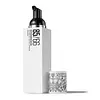bondi sands Technocolor 1 Hour Express Self Tanning Foam Versus Il Makiage 85/66 Magic Moisturizing Sun Foam
What's inside
What's inside
 Key Ingredients
Key Ingredients

No key ingredients
 Benefits
Benefits

 Concerns
Concerns

 Ingredients Side-by-side
Ingredients Side-by-side

Water
Skin ConditioningDihydroxyacetone
Skin ConditioningPropylene Glycol
HumectantTrideceth-9
EmulsifyingPolysorbate 20
EmulsifyingPEG-5 Ethylhexanoate
EmulsifyingGlycerin
HumectantErythrulose
TanningEthoxydiglycol
HumectantAloe Vera Callus Extract
AntioxidantCocos Nucifera Water
MaskingPEG-12 Dimethicone
Skin ConditioningPEG-12 Allyl Ether
PEG-12
HumectantDisodium EDTA
Ethylhexylglycerin
Skin ConditioningPanthenol
Skin ConditioningCI 14700
Cosmetic ColorantCI 19140
Cosmetic ColorantCI 42090
Cosmetic ColorantPhenoxyethanol
PreservativeWater, Dihydroxyacetone, Propylene Glycol, Trideceth-9, Polysorbate 20, PEG-5 Ethylhexanoate, Glycerin, Erythrulose, Ethoxydiglycol, Aloe Vera Callus Extract, Cocos Nucifera Water, PEG-12 Dimethicone, PEG-12 Allyl Ether, PEG-12, Disodium EDTA, Ethylhexylglycerin, Panthenol, CI 14700, CI 19140, CI 42090, Phenoxyethanol
Water
Skin ConditioningDihydroxyacetone
Skin ConditioningCaramel
Cosmetic ColorantErythrulose
TanningDimethyl Isosorbide
SolventTrideceth-9
EmulsifyingPEG-5 Ethylhexanoate
EmulsifyingParfum
MaskingPolysorbate 20
EmulsifyingPhenoxyethanol
PreservativeAloe Barbadensis Leaf Juice
Skin ConditioningHydrolyzed Sodium Hyaluronate
Skin ConditioningPEG-33
HumectantPEG-8 Dimethicone
EmulsifyingBenzoic Acid
MaskingPEG-14
HumectantDehydroacetic Acid
PreservativeCI 16035
Cosmetic ColorantIngredients Explained
These ingredients are found in both products.
Ingredients higher up in an ingredient list are typically present in a larger amount.
Dihydroxyacetone, or DHA, is a simple sugar. It is frequently used in self-tanning products.
DHA binds to the amino acids in your dead skin cells to create a brown/orange color. Darkening begins to kick in a few hours after application and will continue to develop for up to 3 days. This ingredient can be drying.
Both the US and the EU have approved DHA in self-tanning products. In the EU, DHA is allowed at a maximum concentration of 10%. Most tanning products usually contain amounts between 3-5%.
If you are pregnant or have underlying medical conditions, it is best to speak with a dermatologist about using self-tanning products.
Learn more about DihydroxyacetoneWe don't have a description for Erythrulose yet.
We don't have a description for PEG-5 Ethylhexanoate yet.
Phenoxyethanol is a preservative that has germicide, antimicrobial, and aromatic properties. Studies show that phenoxyethanol can prevent microbial growth. By itself, it has a scent that is similar to that of a rose.
It's often used in formulations along with Caprylyl Glycol to preserve the shelf life of products.
Polysorbate 20 is made by combining ethoxylation of sorbitan, ethylene oxide, and lauric acid. It is a mild cleansing agent, surfactant, and emulsifier.
As a surfactant, it helps collect dirt and oils for washing. Emulsifiers prevent oils and water from separating.
Polysorbate 20 also adds scent to a product. Since it is made using sorbitol, it has a sweet scent. Sorbitol can also be found in fruits such as apples and peaches.
The lauric acid used to create Polysorbate 20 is often derived from coconuts.
Polysorbate 20 may not be fungal acne safe.
Learn more about Polysorbate 20We don't have a description for Trideceth-9 yet.
Water. It's the most common cosmetic ingredient of all. You'll usually see it at the top of ingredient lists, meaning that it makes up the largest part of the product.
So why is it so popular? Water most often acts as a solvent - this means that it helps dissolve other ingredients into the formulation.
You'll also recognize water as that liquid we all need to stay alive. If you see this, drink a glass of water. Stay hydrated!
Learn more about Water